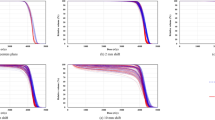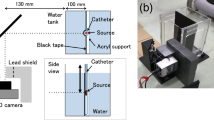Abstract
Balloon-based brachytherapy was developed to simplify the brachytherapy technique and make accelerated partial breast irradiation more accessible to patients with breast cancer who are suitable candidates for this technique. Xoft Axxent® (Xoft, Inc., Sunnyvale, CA) electronic brachytherapy is a novel method of accelerated partial breast irradiation that uses an electronic source to produce X-rays. Xoft Axxent® treatment does not require a high-dose-rate afterloader unit or a shielded vault, unlike other brachytherapy techniques that use iridium-192, such as MammoSite® brachytherapy. Xoft Axxent® is associated with the delivery of less radiation to normal tissues, and increased high radiation dose regions or 'hot spots' to the target volume compared with treatment with the MammoSite® device. Further research will be needed to determine subgroups of patients who might benefit from treatment with Xoft Axxent® electronic brachytherapy.
Key Points
-
Xoft Axxent® electronic brachytherapy is a form of partial breast irradiation that uses an electronic source rather than a radioisotope source
-
Xoft Axxent® electronic brachytherapy does not require a high-dose rate afterloader unit or treatment in a shielded vault
-
Xoft Axxent® is associated with an increased volume of radiation 'hot spots' and less dose to normal tissues than other forms of balloon brachytherapy
-
Further clinical research is needed with Xoft Axxent® electronic brachytherapy
This is a preview of subscription content, access via your institution
Access options
Subscribe to this journal
Receive 12 print issues and online access
$209.00 per year
only $17.42 per issue
Buy this article
- Purchase on Springer Link
- Instant access to full article PDF
Prices may be subject to local taxes which are calculated during checkout



Similar content being viewed by others
References
Veronesi U et al. (2002) Twenty-year follow-up of a randomized study comparing breast-conserving surgery with radical mastectomy for early breast cancer. N Engl J Med 347: 1227–1232
Fisher B et al. (2002) Twenty-year follow-up of a randomized trial comparing total mastectomy, lumpectomy, and lumpectomy plus irradiation for the treatment of invasive breast cancer. N Engl J Med 347: 1233–1241
Cancer Trends Progress Report—2007 Update (online 2007) [http://progressreport.cancer.gov] (accessed 9 December 2008)
Nattinger AB et al. (2000) Relation between appropriateness of primary therapy for early-stage breast carcinoma and increased use of breast-conserving surgery. Lancet 356: 1148–1153
King TA et al. (2000) Long-term results of wide-field brachytherapy as the sole method of radiation therapy after segmental mastectomy for T(is,1,2) breast cancer. Am J Surg 180: 299–304
Vicini FA et al. (2007) Long-term efficacy and patterns of failure after accelerated partial breast irradiation: a molecular assay-based clonality evaluation. Int J Radiat Oncol Biol Phys 68: 341–346
Reitsamer R et al. (2006) The Salzburg concept of intraoperative radiotherapy for breast cancer: results and considerations. Int J Cancer 118: 2882–2887
Polgár C et al. (2007) Breast-conserving treatment with partial or whole breast irradiation for low-risk invasive breast carcinoma—5-year results of a randomized trial. Int J Radiat Oncol Biol Phys 69: 694–702
Veronesi U et al. (2005) Full-dose intraoperative radiotherapy with electrons during breast-conserving surgery: experience with 590 cases. Ann Surg 242: 101–106
Vaidya JS (2007) Partial breast irradiation using targeted intraoperative radiotherapy (Targit). Nat Clin Pract Oncol 4: 384–385
Samuel LM et al. (1999) A pilot study of radical radiotherapy using a perioperative implant following wide local excision for carcinoma of the breast. Breast 8: 95–97
Fentiman IS et al. (1996) Inadequacy of iridium implant as sole radiation treatment for operable breast cancer. Eur J Cancer 32A: 608–611
Dickler A (2007) Technology insight: MammoSite—a new device for delivering brachytherapy following breast-conserving therapy. Nat Clin Pract Oncol 4: 190–196
Benitez PR et al. (2007) Five-year results: the initial clinical trial of MammoSite balloon brachytherapy for partial breast irradiation in early-stage breast cancer. Am J Surg 194: 456–462
Vicini FA et al. (2008) Three-year analysis of treatment efficacy, cosmesis, and toxicity by the American Society of Breast Surgeons MammoSite Breast Brachytherapy Registry Trial in patients treated with accelerated partial breast irradiation (APBI). Cancer 112: 758–766
Kraus-Tiefenbacher U et al. (2006) Long-term toxicity of an intraoperative radiotherapy boost using low energy X-rays during breast-conserving surgery. Int J Radiat Oncol Biol Phys 66: 377–381
Rivard MJ et al. (2006) Calculated and measured brachytherapy dosimetry parameters in water for the Xoft Axxent X-ray source: an electronic brachytherapy source. Med Phys 33: 4020–4032
Dickler A et al. (2007) A dosimetric comparison of MammoSite high-dose-rate brachytherapy and Xoft Axxent electronic brachytherapy. Brachytherapy 6: 164–168
Smitt MC and Kirby R (2007) Dose-volume characteristics of a 50-kV electronic brachytherapy source for intracavitary accelerated partial breast irradiation. Brachytherapy 6: 207–211
Wazer DE et al. (2006) Accelerated partial breast irradiation: an analysis of variables associated with late toxicity and long-term cosmetic outcome after high-dose-rate interstitial brachytherapy. Int J Radiat Oncol Biol Phys 64: 489–495
Mehta VK . et al. (2008) Early experience with an electronic brachytherapy technique for intracavitary accelerated partial breast irradiation [abstract #224]. Proceedings of the 2008 ASCO Breast Cancer Symposium
Author information
Authors and Affiliations
Ethics declarations
Competing interests
Dr Adam Dickler declared he is on the Scientific Advisory Board for Xoft, Inc.
Rights and permissions
About this article
Cite this article
Dickler, A. Xoft Axxent® electronic brachytherapy—a new device for delivering brachytherapy to the breast. Nat Rev Clin Oncol 6, 138–142 (2009). https://doi.org/10.1038/ncponc1319
Received:
Accepted:
Published:
Issue Date:
DOI: https://doi.org/10.1038/ncponc1319
This article is cited by
-
Calculated and measured radiation dose for the low energy xoft axxent eBT X-ray source
BMC Research Notes (2023)
-
A vacuum-sealed miniature X-ray tube based on carbon nanotube field emitters
Nanoscale Research Letters (2012)
-
Surgical perspectives from a prospective, nonrandomized, multicenter study of breast conserving surgery and adjuvant electronic brachytherapy for the treatment of breast cancer
World Journal of Surgical Oncology (2011)
-
Radiation Therapy in Early-Stage Invasive Breast Cancer
Indian Journal of Surgical Oncology (2011)
-
Stable Field Emitters for a Miniature X-ray Tube Using Carbon Nanotube Drop Drying on a Flat Metal Tip
Nanoscale Research Letters (2010)



